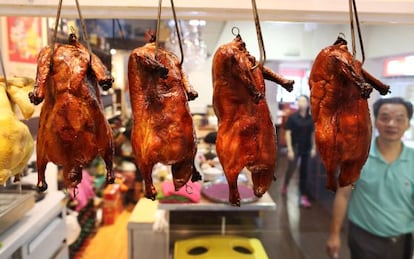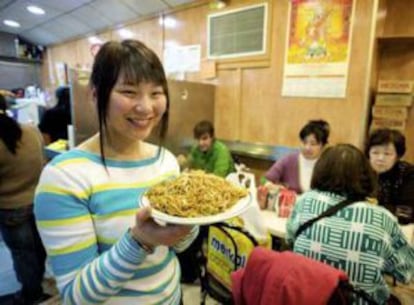Chop suey or wonton? A guide to genuine Chinese restaurants in Spain
El Comidista helps foodies navigate their way through the maze of mediocre fare on offer

The quality of Chinese restaurants in Spain has historically been rather mediocre – and that’s being kind.
Anyone who has traveled abroad – and I’m not even talking about going to China, but to other European countries with decent Chinese restaurants – already knows that the fare they serve here has little in common with the real food from a country that can boast one of the world’s most magnificent cuisines.
Fortunately, a growing native community in Spain has led to the appearance of what I call “Chinese Chinese” restaurants, which bear little resemblance to their “just plain Chinese” counterparts.
Chinese people eat at Chinese Chinese restaurants, not at Chinese restaurants
These are the nine differences that will allow you to tell them apart:
1. Run-of-the-mill Chinese restaurants offer dishes that you will never see in China, but were instead created by Asian immigrants in the United States: “three delights” fried rice, spring rolls, chop suey, sweet-and-sour pork and so on. But a Chinese Chinese establishment does not have these things, or if it does, it’s only for clueless foreigners like ourselves. Sometimes they have two menus: Menu A for non-Chinese diners and Menu B with the really good stuff.
2. A Chinese Chinese restaurant has truly delicious dishes such as noodle soups, jiaozi dumplings, dim sum, wonton dumplings, xiaolongbao steamed buns, hot pots and a thousand other varieties of regional food that you will never, ever find at Chinese restaurants of the garden variety.

3. A real Chinese restaurant serves knock-you-off-your-feet stews made with animals’ less noble parts, taking the concept of cooking with offal to an unknown dimension. A standard Chinese restaurant does not dare do this, because it doesn’t want to offend you with, say, grilled pork lungs.
4. Chinese people eat at Chinese Chinese restaurants, not at Chinese restaurants.
5. A regular Chinese restaurant goes easy on the spices out of consideration for its local patrons. But if you happen to be sitting inside a Chinese Chinese restaurant whose owners come from southern China, you mouth will burn as though you were in the Sichuan heartland.
6. Waiters at ordinary Chinese restaurants speak pretty decent Spanish, and you can communicate with them without too much trouble. But at genuine Chinese Chinese restaurants, there is typically just one person who speaks a smattering of Spanish, and confusion ensues when you place your order. This is part of the charm, and it allows you to discover new dishes.
7. Generally speaking, the decoration at ordinary Chinese restaurants is awful – think of those pagoda replicas and lacquered surfaces. The Chinese Chinese establishments are even uglier: Venetian stucco, chairs with plastic-covered seats and indescribable paintings everywhere you look. The overall feeling is one of decadence, and the only reason you actually walk in is because somebody recommended it – otherwise, you would run out screaming.
8. Ordinary Chinese restaurants have names like The Happy Buddha or The Great Wall and so on. The Chinese Chinese restaurants either have a name that’s in Chinese, or a Spanish name handed down from the previous business that occupied the premises, such as “Don Pepe.”
9. Your everyday Chinese restaurant is cheap, and your dining experience ranges from bad to regular. The Chinese Chinese restaurant is equally inexpensive, but you dine like an emperor from the Ming dynasty – or almost.
English version by Susana Urra.
Where to find Chinese Chinese restaurants
Madrid has the largest number of them. The pioneer is the underground restaurant outside the entrance to the public parking lot in Plaza de España. But there are others with a good reputation, such as Nihao (C/ Silva, 20), Hui Fon (C/ Maestro Arbós, 3), Ohua (C/ Tomás García, 3) and Rey de Tallarines (C/ Plaza del Conde Toreno, 2). For hot pots, check out Yuè Lái (C/ Hermosilla, 101)
Barcelona has a Chinese Chinese restaurant on Calle Ali Bei, 65. It has no Spanish or Catalan name, the food is really inexpensive and the homemade pasta soups are sensational. For hot pots, a decent choice is La Olla de Sichuán (C/ Dr. Letamendi, 11), while the spicy eggplants served at La Casa del Xinés have a reputation all their own.
Valencia has a place called Bar Sueca (C/ Sueca, 65) that is highly recommended by the locals.
In Bilbao, seekers of the real deal turn religiously to León de Oro, on Calle Fernández del Campo, 8.
Alicante would surely win the prize for best name for a Chinese Chinese restaurant with Mari Carmen, located on Plaza de Galicia.
Tu suscripción se está usando en otro dispositivo
¿Quieres añadir otro usuario a tu suscripción?
Si continúas leyendo en este dispositivo, no se podrá leer en el otro.
FlechaTu suscripción se está usando en otro dispositivo y solo puedes acceder a EL PAÍS desde un dispositivo a la vez.
Si quieres compartir tu cuenta, cambia tu suscripción a la modalidad Premium, así podrás añadir otro usuario. Cada uno accederá con su propia cuenta de email, lo que os permitirá personalizar vuestra experiencia en EL PAÍS.
¿Tienes una suscripción de empresa? Accede aquí para contratar más cuentas.
En el caso de no saber quién está usando tu cuenta, te recomendamos cambiar tu contraseña aquí.
Si decides continuar compartiendo tu cuenta, este mensaje se mostrará en tu dispositivo y en el de la otra persona que está usando tu cuenta de forma indefinida, afectando a tu experiencia de lectura. Puedes consultar aquí los términos y condiciones de la suscripción digital.
Últimas noticias
The complicated life of Francesca Albanese: A rising figure in Italy but barred from every bank by Trump’s sanctions
How Japan is trying to avert ‘digital defeat’
Half of Scotland is in the hands of 420 property owners
Reinhard Genzel, Nobel laureate in physics: ‘One-minute videos will never give you the truth’
Most viewed
- Pablo Escobar’s hippos: A serious environmental problem, 40 years on
- Why we lost the habit of sleeping in two segments and how that changed our sense of time
- Charles Dubouloz, mountaineering star, retires at 36 with a farewell tour inspired by Walter Bonatti
- Reinhard Genzel, Nobel laureate in physics: ‘One-minute videos will never give you the truth’
- The Florida Keys tourist paradise is besieged by immigration agents: ‘We’ve never seen anything like this’









































